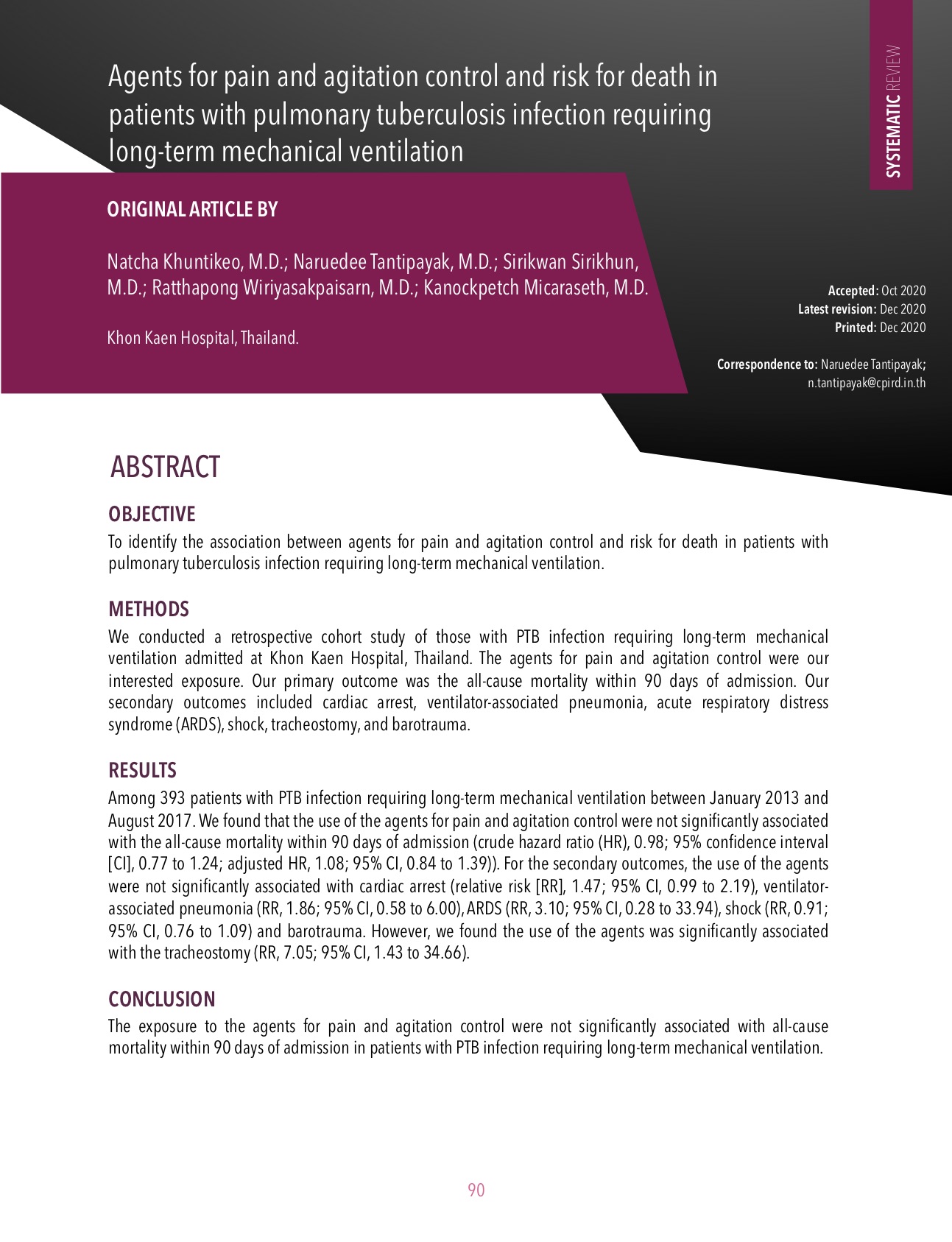Agents for pain and agitation control and risk for death in patients with pulmonary tuberculosis infection requiring long-term mechanical ventilation
บทคัดย่อ
BACKGROUND
To identify the association between agents for pain and agitation control and risk for death in patients with pulmonary tuberculosis infection requiring long-term mechanical ventilation
METHODS
We conducted a retrospective cohort study of those with PTB infection requiring long-term mechanical ventilation admitted at Khon Kaen Hospital, Thailand. The agents for pain and agitation control were our interested exposure. Our primary outcome was the all-cause mortality within 90 days of admission. Our secondary outcomes included cardiac arrest, ventilator-associated pneumonia, acute respiratory distress syndrome (ARDS), shock, tracheostomy, and barotrauma.
RESULTS
Among 393 patients with PTB infection requiring long-term mechanical ventilation between January 2013 and August 2017. We found that the use of the agents for pain and agitation control were not significantly associated with the all-cause mortality within 90 days of admission (crude hazard ratio (HR), 0.98; 95% confidence interval [CI], 0.77 to 1.24; adjusted HR, 1.08; 95% CI, 0.84 to 1.39)). For the secondary outcomes, the use of the agents were not significantly associated with cardiac arrest (relative risk [RR], 1.47; 95% CI 0.99 to 2.19), ventilator-associated pneumonia (RR, 1.86; 95% CI 0.58 to 6.00), ARDS (RR, 3.10; 95% CI 0.28 to 33.94), shock (RR, 0.91; 95% CI 0.76 to 1.09) and barotrauma. However, we found the use of the agents was significantly associated with the tracheostomy (RR, 7.05; 95% CI 1.43 to 34.66).
CONCLUSIONS
The exposure to the agents for pain and agitation control were not significantly associated with all-cause mortality within 90 days of admission in patients with PTB infection requiring long-term mechanical ventilation.
เอกสารอ้างอิง
WHO | Global tuberculosis report 2017 [Internet]. WHO. [cited 2018 Feb 10]. Available from: http://www.who.int/tb/publications/global_report/en/
Erbes R, Oettel K, Raffenberg M, Mauch H, Schmidt-Ioanas M, Lode H. Characteristics and outcome of patients with active pulmonary tuberculosis requiring intensive care. Eur Respir J. 2006 Jun;27(6):1223–8.
Lee PL, Jerng JS, Chang YL, Chen CF, Hsueh PR, Yu CJ, et al. Patient mortality of active pulmonary tuberculosis requiring mechanical ventilation. Eur Respir J. 2003 Jul;22(1):141–7.
Ryu YJ, Koh W-J, Kang EH, Suh GY, Chung MP, Kim H, et al. Prognostic factors in pulmonary tuberculosis requiring mechanical ventilation for acute respiratory failure. Respirol Carlton Vic. 2007 May;12(3):406–11.
Valade S, Raskine L, Aout M, Malissin I, Brun P, Deye N, et al. Tuberculosis in the intensive care unit: A retrospective descriptive cohort study with determination of a predictive fatality score. Can J Infect Dis Med Microbiol J Can Mal Infect Microbiol Medicale. 2012;23(4):173–8.
Filiz KA, Levent D, Emel E, Pelin U, Turkay A, Aybüke K. Characteristics of Active Tuberculosis Patients Requiring Intensive Care Monitoring and Factors Affecting Mortality. Tuberc Respir Dis. 2016 Jul;79(3):158–64.
Bhurayanontachai R, Maneenil K. Factors influencing development and mortality of acute respiratory failure in hospitalized patient with active pulmonary tuberculosis: a 10-year retrospective review. J Thorac Dis. 2016 Jul;8(7):1721–30.
Loh WJ, Yu Y, Loo CM, Low SY. Factors associated with mortality among patients with active pulmonary tuberculosis requiring intensive care. Singapore Med J. 2017 Nov;58(11):656–9.
Douglas SL, Daly BJ, Gordon N, Brennan PF. Survival and quality of life: short-term versus long-term ventilator patients. Crit Care Med. 2002 Dec;30(12):2655–62.
Williams TA, Martin S, Leslie G, Thomas L, Leen T, Tamaliunas S, et al. Duration of mechanical ventilation in an adult intensive care unit after introduction of sedation and pain scales. Am J Crit Care Off Publ Am Assoc Crit-Care Nurses. 2008 Jul;17(4):349–56.
Pandharipande PP, Patel MB, Barr J. Management of pain, agitation, and delirium in critically ill patients. Pol Arch Med Wewn. 2014;124(3):114–23.
Egerod I, Christensen BV, Johansen L. Trends in sedation practices in Danish intensive care units in 2003: a national survey. Intensive Care Med. 2006 Jan;32(1):60–6.
Arroliga A, Frutos-Vivar F, Hall J, Esteban A, Apezteguía C, Soto L, et al. Use of sedatives and neuromuscular blockers in a cohort of patients receiving mechanical ventilation. Chest. 2005 Aug;128(2):496–506.
Strøm T, Martinussen T, Toft P. A protocol of no sedation for critically ill patients receiving mechanical ventilation: a randomised trial. Lancet Lond Engl. 2010 Feb 6;375(9713):475–80.
Sarmiento OL, Weigle KA, Alexander J, Weber DJ, Miller WC. Assessment by Meta-Analysis of PCR for Diagnosis of Smear-Negative Pulmonary Tuberculosis. J Clin Microbiol. 2003 Jul;41(7):3233–40.
Khalil KF, Butt T. Diagnostic yield of Bronchoalveolar Lavage gene Xpert in smear-negative and sputum-scarce pulmonary tuberculosis. J Coll Physicians Surg--Pak JCPSP. 2015 Feb;25(2):115–8.
WHO | Definitions and reporting framework for tuberculosis [Internet]. [cited 2018 Mar 4]. Available from: http://www.who.int/tb/publications/definitions/en/
Treatment of Tuberculosis: Guidelines [Internet]. 4th ed. Geneva: World Health Organization; 2010 [cited 2018 Mar 4]. (WHO Guidelines Approved by the Guidelines Review Committee). Available from: http://www.ncbi.nlm.nih.gov/books/NBK138748/



